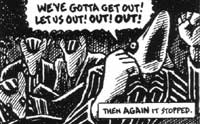As the Wall Street Journal states on the back of the Maus, the book is “the most affecting and successful narrative ever done about the Holocaust.” This is odd seeing as Maus is a graphic narrative. Most narratives that cover the Holocaust are done using words and pictures separately. Generally such a narrative would be either a book with a lot of words and a couple pictures, or a book with a lot of pictures and just a few words in the caption. The difference between these regular narratives and graphic narratives is that in graphic narratives, the words and pictures are mixed. Comics use words in pictures, and also put pictures amidst words. This is called cross-discursive narration, or narration across two mediums—image and text. This use of both mediums allows for the fast, easy absorption of information because of the image. Usually, a quick glance at a picture gives you the idea behind it. Meanwhile, cross-discursive narration communicates much more information than an image alone because of the added text. The text goes into greater detail, and adds to the visual argument the image presents. Maus in particular is a cross-discursive narrative that quite easily communicates profound arguments to its readers. The comics portray the Jews of the Holocaust as mice, while showing the Nazis as cats. This display of cats and mice creates an easily understood analogy of the conflict between the two species. You have heard of Tom and Jerry. And even if you haven’t, it is natural to imagine enmity between cats and mice. In many different ways, these juvenile cartoon-like comics communicate themes such as the conflict between Jews and Nazis quickly and easily, while not losing the depth and reality of the Holocaust.
The picture I chose shows how simply and quickly Maus communicates a theme. It shows the desperation that the Jews had during the war, while only using a few words and a single image.
